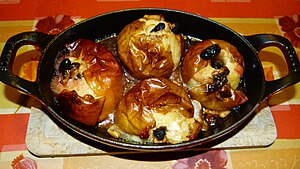
German baked apples (German: Bratapfel) are a German dish of baked apples traditionally made with the Dutch Belle de Boskoop apple.[1] They can be prepared with many different fillings and are a common Christmas dish.[2] Often they are served with vanilla custard.[3]
Background
[edit]Apples are the most widely grown fruit in Germany, used to prepare many dishes and beverages in German cuisine.[4] Apples were the only locally grown fruit in Germany that kept during the winter months, which made baked apples an economical choice for holiday desserts in the Christmas traditions of Germany or as a sweet main dish in cold weather.[1][5]
Preparation
[edit]The whole apples once cored can be stuffed with assorted fillings made from chopped almonds, marzipan, raisins, rum, butter, lemon juice, sugar, spices and other ingredients. Some versions are baked in a baking dish with white wine and honey and baked until tender. They are usually served with vanilla custard or ice cream.[6]
Apples can be baked on top of a wood stove or in the oven in round enamel cast iron dishes called "apple schnitzers". The dish has a spike in the center that cooks the cored apple from the inside out. Schnitzers may be a German invention, no longer widely used in Germany, but still found among Amish communities in the United States.[7]
See also
[edit]References
[edit]- ^ a b "German Baked Apples (Bratapfeln)". The Spruce Eats.
- ^ Boone, Mary (15 September 2011). Midwestern Recipes. Mitchell Lane Publishers. ISBN 9781612281650.
- ^ Heinzelmann, Ursula (2008). Food Culture in Germany. ABC-CLIO. ISBN 9780313344947.
- ^ "Baked Apples with Marzipan and Cranberry".
- ^ The World Religions Cookbook. Greenwood Press. 2007. p. 63. ISBN 9780313342639.
- ^ Baked Apples Offer a Taste of Germany
- ^ "Baking Apples in a Schnitzer". Smithsonian Magazine. November 6, 2009.
Well, that’s interesting to know that Psilotum nudum are known as whisk ferns. Psilotum nudum is the commoner species of the two. While the P. flaccidum is a rare species and is found in the tropical islands. Both the species are usually epiphytic in habit and grow upon tree ferns. These species may also be terrestrial and grow in humus or in the crevices of the rocks.
View the detailed Guide of Psilotum nudum: Detailed Study Of Psilotum Nudum (Whisk Fern), Classification, Anatomy, Reproduction